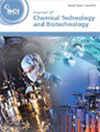Saurav Mishra, Nandana Chakinala, Anand G. Chakinala, Praveen K. Surolia
求助PDF
{"title":"用于光催化硝基苯分解的 Bi/Zn 浸渍商用 TiO2 纳米粒子的性能评估","authors":"Saurav Mishra, Nandana Chakinala, Anand G. Chakinala, Praveen K. Surolia","doi":"10.1002/jctb.7666","DOIUrl":null,"url":null,"abstract":"<div>\n \n \n <section>\n \n <h3> BACKGROUND</h3>\n \n <p>Commercial TiO<sub>2</sub> nanoparticles were subjected to modification through Bi and Zn metal doping. The resulting catalysts were comprehensively characterized, and their performance was then reviewed for removal of model pollutant nitrobenzene in water.</p>\n </section>\n \n <section>\n \n <h3> RESULTS</h3>\n \n <p>Amidst the synthesized catalysts, the co-doping of Bi/Zn (0.25:0.75 wt%) demonstrated the best photocatalytic degradation activity, achieving 95% degradation within 90 min of reaction time, with 2.99 × 10<sup>−2</sup> min<sup>−1</sup> rate constant value. The involvement of different radicals during the degradation process was elucidated by employing appropriate radical scavengers. Furthermore, the degradation results were investigated applying the first-order kinetic model, leading to the determination of reaction rate constants and initial rates of the degradation process.</p>\n </section>\n \n <section>\n \n <h3> CONCLUSION</h3>\n \n <p>An improved photocatalytic activity was observed with metal doping due to the synergistic effect of doped metals with commercial TiO<sub>2</sub> and profound charge transfer among them. It was observed that performance was increased with temperature rise in the practical range of application, that is, 5–20 °C. This behavior was due to high rate of movement of charge carriers. Further, involvement and functioning of various radical species such as h<sup>+</sup>, OH<sup>−</sup> and O<sub>2</sub><sup>−</sup> in nitrobenzene degradation were successfully established using appropriate radical scavengers. © 2024 Society of Chemical Industry (SCI).</p>\n </section>\n </div>","PeriodicalId":15335,"journal":{"name":"Journal of chemical technology and biotechnology","volume":"99 8","pages":"1779-1787"},"PeriodicalIF":2.8000,"publicationDate":"2024-05-17","publicationTypes":"Journal Article","fieldsOfStudy":null,"isOpenAccess":false,"openAccessPdf":"","citationCount":"0","resultStr":"{\"title\":\"Performance evaluation of Bi/Zn-impregnated commercial TiO2 nanoparticles for photocatalytic nitrobenzene decomposition\",\"authors\":\"Saurav Mishra, Nandana Chakinala, Anand G. Chakinala, Praveen K. Surolia\",\"doi\":\"10.1002/jctb.7666\",\"DOIUrl\":null,\"url\":null,\"abstract\":\"<div>\\n \\n \\n <section>\\n \\n <h3> BACKGROUND</h3>\\n \\n <p>Commercial TiO<sub>2</sub> nanoparticles were subjected to modification through Bi and Zn metal doping. The resulting catalysts were comprehensively characterized, and their performance was then reviewed for removal of model pollutant nitrobenzene in water.</p>\\n </section>\\n \\n <section>\\n \\n <h3> RESULTS</h3>\\n \\n <p>Amidst the synthesized catalysts, the co-doping of Bi/Zn (0.25:0.75 wt%) demonstrated the best photocatalytic degradation activity, achieving 95% degradation within 90 min of reaction time, with 2.99 × 10<sup>−2</sup> min<sup>−1</sup> rate constant value. The involvement of different radicals during the degradation process was elucidated by employing appropriate radical scavengers. Furthermore, the degradation results were investigated applying the first-order kinetic model, leading to the determination of reaction rate constants and initial rates of the degradation process.</p>\\n </section>\\n \\n <section>\\n \\n <h3> CONCLUSION</h3>\\n \\n <p>An improved photocatalytic activity was observed with metal doping due to the synergistic effect of doped metals with commercial TiO<sub>2</sub> and profound charge transfer among them. It was observed that performance was increased with temperature rise in the practical range of application, that is, 5–20 °C. This behavior was due to high rate of movement of charge carriers. Further, involvement and functioning of various radical species such as h<sup>+</sup>, OH<sup>−</sup> and O<sub>2</sub><sup>−</sup> in nitrobenzene degradation were successfully established using appropriate radical scavengers. © 2024 Society of Chemical Industry (SCI).</p>\\n </section>\\n </div>\",\"PeriodicalId\":15335,\"journal\":{\"name\":\"Journal of chemical technology and biotechnology\",\"volume\":\"99 8\",\"pages\":\"1779-1787\"},\"PeriodicalIF\":2.8000,\"publicationDate\":\"2024-05-17\",\"publicationTypes\":\"Journal Article\",\"fieldsOfStudy\":null,\"isOpenAccess\":false,\"openAccessPdf\":\"\",\"citationCount\":\"0\",\"resultStr\":null,\"platform\":\"Semanticscholar\",\"paperid\":null,\"PeriodicalName\":\"Journal of chemical technology and biotechnology\",\"FirstCategoryId\":\"5\",\"ListUrlMain\":\"https://onlinelibrary.wiley.com/doi/10.1002/jctb.7666\",\"RegionNum\":4,\"RegionCategory\":\"生物学\",\"ArticlePicture\":[],\"TitleCN\":null,\"AbstractTextCN\":null,\"PMCID\":null,\"EPubDate\":\"\",\"PubModel\":\"\",\"JCR\":\"Q3\",\"JCRName\":\"BIOTECHNOLOGY & APPLIED MICROBIOLOGY\",\"Score\":null,\"Total\":0}","platform":"Semanticscholar","paperid":null,"PeriodicalName":"Journal of chemical technology and biotechnology","FirstCategoryId":"5","ListUrlMain":"https://onlinelibrary.wiley.com/doi/10.1002/jctb.7666","RegionNum":4,"RegionCategory":"生物学","ArticlePicture":[],"TitleCN":null,"AbstractTextCN":null,"PMCID":null,"EPubDate":"","PubModel":"","JCR":"Q3","JCRName":"BIOTECHNOLOGY & APPLIED MICROBIOLOGY","Score":null,"Total":0}
引用次数: 0
引用
批量引用

 求助内容:
求助内容: 应助结果提醒方式:
应助结果提醒方式:


